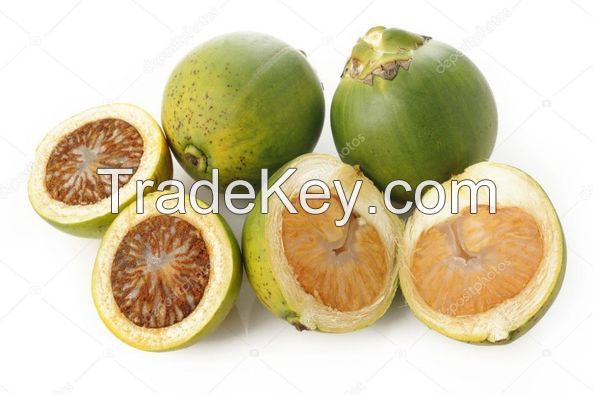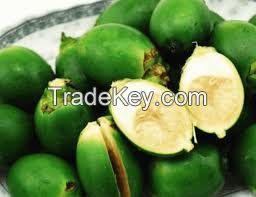





离岸价格
获取最新报价1.25 ~ 2 USD / Kilogram ( Negotiable )
|1000 Kilogram Minimum Order
国家:
Vietnam
型号:
Tracy areca fruit - H972
离岸价格:
1.25 ~ 2 USD / Kilogram ( Negotiable ) 获取最新报价
位置:
Vietnam
最小订单价格:
1.25 per Kilogram
最小订单:
1000 Kilogram
包装细节:
customer's request
交货时间:
10 to 15 days
供应能力:
10000 Kilogram per Day
付款方式:
Western Union, L/C, T/T
產品組 :
Introduction
The Areca fruit, also known as betel nut or areca nut, is a tropical fruit that has been integral to various cultures, particularly in Asia. Derived from the Areca palm (Areca catechu), this fruit is renowned for its traditional uses and diverse applications. Its significance spans from cultural rituals to medicinal uses and culinary applications. This comprehensive guide will explore the Areca fruit's botanical characteristics, cultural significance, health benefits, and market trends.
1. Botanical Characteristics
a. Plant Description
The Areca palm is a tropical tree that grows to a height of ****0 meters. It has a slender trunk and pinnate leaves that can reach up to 3 meters in length. The Areca palm is predominantly found in tropical and subtropical regions, particularly in Southeast Asia, the Indian subcontinent, and parts of Africa.
b. Fruit Description
The Areca fruit, also known as the Areca nut, is a seed enclosed in a fibrous husk. When mature, the fruit is about **5 cm in diameter and can be round or oval in shape. The outer layer of the fruit is green and fibrous, which turns brown as it dries. The inner nut is the part that is often consumed or used in various applications.
c. Growth and Harvesting
Areca palms thrive in well-drained, fertile soil and require a humid, tropical climate to grow effectively. The fruit typically matures within **8 months after flowering. Harvesting involves cutting the mature fruit clusters from the palm, and the nuts are then separated from the husks. The nuts are often dried before use.
2. Cultural Significance
a. Traditional Uses
Areca nuts have played a significant role in traditional practices across various cultures. They are commonly chewed along with betel leaves (Piper betle), lime, and sometimes other flavorings, creating a combination known as betel quid. This practice is prevalent in many Asian cultures, including India, Bangladesh, Sri Lanka, Thailand, and the Philippines.
b. Rituals and Ceremonies
In many cultures, chewing betel quid is associated with social and ritualistic significance. It is often used during religious ceremonies, marriage celebrations, and other auspicious occasions. The act of sharing betel quid is a gesture of hospitality and respect.
c. Medicinal Uses
Traditional medicine has long used Areca nuts for various purposes. They are believed to have digestive, antiparasitic, and astringent properties. In some cultures, Areca nuts are used in preparations to treat digestive disorders, dysentery, and even as an appetite .
3. Health Benefits
a. Nutritional Profile
Areca nuts are rich in several nutrients, including carbohydrates, proteins, and fats. They also contain various vitamins and minerals, such as vitamin C, vitamin B complex, calcium, potassium, and magnesium. Despite their nutritional benefits, it is essential to note that Areca nuts also contain compounds that can have adverse health effects.
b. Digestive Health
One of the traditional uses of Areca nuts is to aid digestion. They are believed to stimulate the digestive system and help alleviate issues such as indigestion and constipation. The nuts are also known for their astringent properties, which can help tone and tighten the mucous membranes of the digestive tract.
c. Antiparasitic Effects
Areca nuts have been traditionally used as a natural remedy for intestinal parasites. They are believed to have anthelmintic properties, which can help expel parasites such as worms from the digestive system. However, modern scientific evidence supporting these claims is limited.
d. Mental Stimulation
The arecoline compound found in Areca nuts has effects on the central nervous system. It can enhance alertness and concentration, similar to the effects of caffeine. This stimulating effect has contributed to the traditional use of Areca nuts as a cognitive enhancer.
e. Oral Health
In some cultures, chewing Areca nuts is thought to have oral health benefits. It is believed to help maintain oral hygiene by stimulating saliva production and reducing the risk of oral infections. However, excessive consumption can lead to adverse oral health effects, such as staining of the teeth and gum issues.
4. Risks and Side Effects
a. Health Risks
While Areca nuts have traditional uses and some purported health benefits, they also come with potential health risks. The primary compound of concern is arecoline, which has been associated with various health issues:
b. Adverse Effects
Regular consumption of Areca nuts can lead to staining of the teeth and gums, as well as oral mucosal lesions. Additionally, it may cause digestive discomfort and exacerbate existing health conditions.
c. Interaction with Medications
Areca nuts can interact with certain medications, particularly those affecting the central nervous system and cardiovascular system. It is essential to consult a healthcare provider before consuming Areca nuts if you are on medication or have underlying health conditions.
5. Economic and Market Trends
a. Global Demand
The demand for Areca nuts varies globally, with significant consumption in countries like India, Bangladesh, and Thailand. In recent years, there has been a growing interest in Areca nuts in international markets, driven by their traditional use and potential health benefits.
b. Market Segments
The Areca nut market can be segmented into several categories:
c. Export and Trade
Several countries export Areca nuts to international markets, contributing to the global supply chain. India is a major exporter, with significant trade routes to regions such as the Middle East and Southeast Asia. The growing awareness of Areca nuts' traditional uses and potential benefits is driving the expansion of export opportunities.
d. Sustainability and Ethical Considerations
There is an increasing focus on sustainable and ethical practices in the production of Areca nuts. This includes ensuring fair trade practices, reducing environmental impact, and supporting local communities involved in cultivation and processing. Sustainable practices help improve the overall quality of the product and contribute to ethical consumerism.
6. Culinary Uses and Innovations
a. Traditional Recipes
Areca nuts are often used in traditional recipes, particularly in Southeast Asian cuisines. They are a key ingredient in betel quid, which is commonly chewed for its stimulating effects and as part of social rituals. Additionally, Areca nuts are used in some regional sweets and confectioneries.
b. Modern Innovations
Recent innovations have explored new ways to incorporate Areca nuts into modern culinary applications. This includes:
c. Culinary Challenges
Incorporating Areca nuts into modern cuisine presents certain challenges, including managing their bitter taste and ensuring that products comply with health regulations. Innovations in processing and flavor enhancement are addressing these challenges to make Areca nut products more appealing and accessible.
7. Conclusion
The Areca fruit, or Areca nut, is a remarkable tropical product with deep cultural roots and a variety of applications. Its significance in traditional practices, coupled with its nutritional and medicinal properties, makes it a unique ingredient in the global marketplace. However, it is essential to be aware of the potential health risks associated with Areca nuts and to consume them in moderation.
As global interest in traditional and functional foods grows, Areca nuts are likely to see increased demand and innovation. The balance between preserving traditional uses and exploring modern applications will shape the future of Areca fruit in the global market. By understanding its benefits, risks, and market dynamics, consumers and businesses can make informed decisions about incorporating Areca nuts into their diets and product offerings.
| 国家: | Vietnam |
| 型号: | Tracy areca fruit - H972 |
| 离岸价格: | 1.25 ~ 2 / Kilogram ( Negotiable ) 获取最新报价 |
| 位置: | Vietnam |
| 最小订单价格: | 1.25 per Kilogram |
| 最小订单: | 1000 Kilogram |
| 包装细节: | customer's request |
| 交货时间: | 10 to 15 days |
| 供应能力: | 10000 Kilogram per Day |
| 付款方式: | Western Union, L/C, T/T |
| 產品組 : | agriculture |




